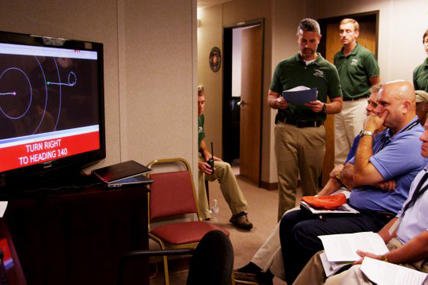WASHINGTON -- By March 2014, the MQ-1C Gray Eagle, an Army unmanned aerial system, or UAS, will be able to train in the same airspace as the Boeing 747, with the help of the Army-developed Ground Based Sense and Avoid system.
The Army recently concluded a two-week demonstration of the Ground Based Sense and Avoid system, or GBSAA, at Dugway Proving Ground, Utah. During the demonstration, the Army put the system through multiple training "vignettes" that validated both the design and functionality of the system.
"We are ready to begin the certification process in order to be fielding in March 2014, for the Gray Eagle locations," said Viva Austin, product director for the Army's Unmanned Systems Airspace Integration.
The five locations for Gray Eagle basing and training include Fort Hood, Texas; Fort Riley, Kan.; Fort Stewart, Ga.; Fort Campbell, Ky.; and Fort Bragg, N.C. It's expected the first system will field in March 2014 at Fort Hood. About three months later, the system should field to Fort Riley. All five sites should be equipped with the GBSAA system by 2015, officials said.
The GBSAA is a radar and warning system designed to allow Soldiers to fly unmanned aerial systems, like the Gray Eagle, inside the National Air Space, while still meeting Federal Aviation Administration regulations. The system monitors location and altitude of the UAS and other aircraft, detects possible collisions, and makes recommendations to UAS operators on how to avoid those collisions.
As unmanned aerial systems and the Soldiers who fly them return home from theater, the Army needs a way to keep those UAS operators trained for the next battle, and they need to do that training inside the United States and inside the National Air Space, or NAS.
The Federal Aviation Administration, or FAA, requires a pilot be able to "see and avoid" other aircraft flying in the same airspace. But a UAS has no pilot onboard. The Army can get around that by meeting other requirements, however. The Army can fly a UAS in the NAS with a chase aircraft following the UAS, for instance. It is also possible to fly in the NAS if a trained observer is watching the UAS. But the observer must be within one mile and 3,000 feet of the vehicle.
Additionally, the Army can't fly the UAS in NAS at night.
The GBSAA was developed as an "alternate means of compliance" for the FAA's "see and avoid" requirement. The system senses other traffic in the area, using a 3D radar system, and uses algorithms to determine if there is danger of collision and how to avoid that danger. That information is provided to the UAS operator.
When the FAA approves the system for use, the Army will be able to train UAS pilots any time of day.
"It's a significant impact [on training]," said Austin. "It does two things. One is it allows us to not need to put chase planes out to follow the aircraft over. It allows us to not have ground observers standing out there, trying to separate traffic. And it allows us to fly through the night hours, it gives us 24-hour operations, GBSAA allows that and opens it up."
The recent demonstration of the GBSAA involved seven vignettes at Dugway Proving Ground, involving both live and synthetic UAVs, as well as synthetic "intruders."
The first three vignettes used real UAS. In vignettes 1 and 2, a real Hunter UAS flew at Dougway against synthetic "intruders" in their airspace. The difference between the two vignettes was the version of the GBSAA used. In both scenarios, the system performed without endangering the mission, but on the second run, the Army Phase 2 Block 0 system's improved algorithms indicated an earlier, safer departure time between the two intruders.
Vignette 3 pitted two live Shadow UAS against each other. One of the Shadows served as the intruder aircraft, the other was guided by the GBSAA. The operator of that aircraft was warned at an appropriate time and was able to follow the recommended maneuver to avoid the other aircraft.
The next three vignettes showed the adaptability of the Phase 2 Block 0 algorithms. They were flown using synthetic UAS, through the X-Plane system. Each of the three vignettes used replicated airspace over different military installations, including Marine Corps Air Station, Cherry Point, N.C.; Fort Stewart, Ga.; and Fort Drum, N.Y.
Finally, in vignette 7, the GBSAA system was demonstrated again using a synthetic UAS, but was flown against live aviation traffic data around nearby Salt Lake City, and also against recorded air traffic data from Boston's Logan Airport.
"In both cases we were extremely successful and (it) was even more than we had hoped for," Austin said.
Austin said it was difficult to get the GBSAA system into a tough situation that it couldn't handle.
"The hardest part of that was actually trying to get into a situation where the maneuver algorithm was really tested, getting into a red condition," Austin said. "Big sky theory kind of held true, we almost felt like we were trying to chase people down at that point because air traffic control keeps people separated so well, it was kind of hard to put yourself in a really stressing situation and test those algorithms out really well. It was very safe and we demonstrated that the system and the test bed was really successful."
Austin did say one thing learned about the GBSAA is that the algorithm used to safely move UAS through airspace does not always do things conventionally, as pilots would do them. Austin said that they will try to work more standard ways into the system, if they can do so without breaking the algorithm.



























